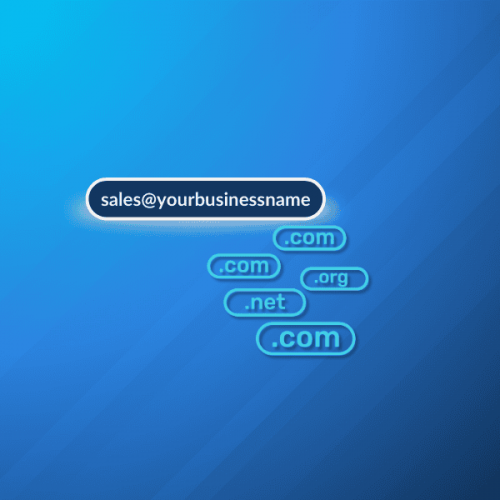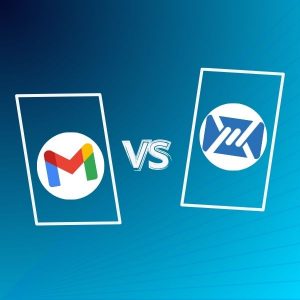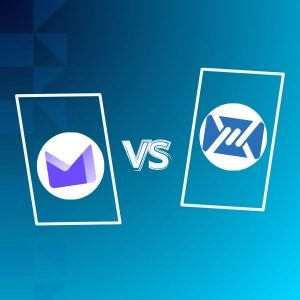Ever wondered how people get those fancy custom email domains? Tired of being stuck with a generic “@gmail.com” address?
Then you’ve come to the right place! In this guide, we will explore everything you need to know about custom email domains, from purchasing your first domain name to setting it up with your email provider.
So without further ado, let’s explore.
Sign up to the Mailfence Newsletter!
Stay up-to-date with the latest news in the world of online privacy and cybersecurity
What is an Email Domain?
Before going into custom domains, let’s define what an email domain is first.
An email address typically has a format like yourname@mailfence.com. Let’s break down each part.
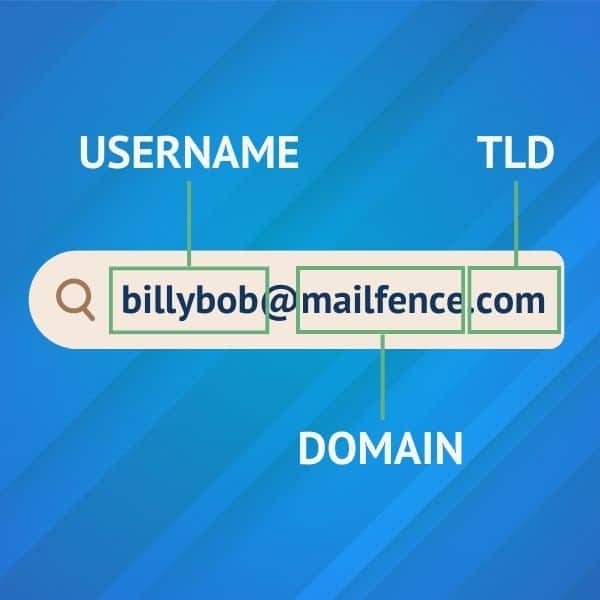
The email domain is located after the @ symbol. In this case, the domain is “mailfence”. The domain basically identifies to which server emails need to be routed. When somebody sends an email to an @mailfence.com address, the email provider knows to route the email to Mailfence’s servers.
Right before the @ symbol, we have the username. This identifies the recipient of the email within those servers.
Finally, the “.com” section is called the Top Level Domain, or TLD. This could be .com, .org, or country-specific TLDs such as .be, .co.uk and more.
What is a Custom Email Domain?
Now that we’ve identified what an email domain is, what is a custom email domain?
When you create an account with an email provider, you get their default email domain.
Want to create a Gmail account (we advise against it btw)? That will be “johndoe@gmail.com”. Want to create a Mailfence account? By default, that will be “yourname@mailfence.com” (even though we let you set your own email domain, more on that later 😉).
However, you have surely seen people using email addresses such as “johndoe@johndoecompany.com”, or “janedoe@doefamily.com”. That is precisely what a custom email domain is.
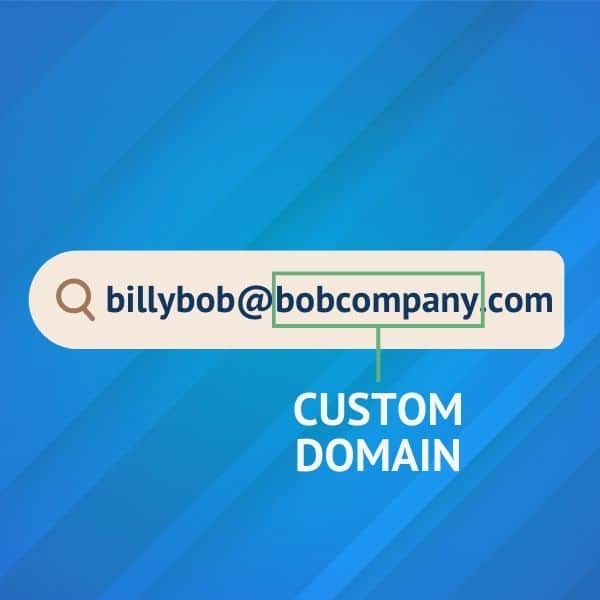
A custom email domain is basically your own personalized email domain. You are still using Gmail or Yahoo or Mailfence, but you are simply replacing their default domain with your own.
But how do you get your custom email domain? Where do you get it? Do you need to pay for it? Let’s answer all of these questions.
Looking to create an email account with no phone number required? Check out our latest guide here.
How Do I Get My Own Custom Email Domain?
A custom email domain must be bought to possess the right to use it. This means there are two steps you need to follow before being able to use a custom email domain:
- Step 1 – Registering a domain name
- Step 2 – Setting up that domain name for your email address
Let’s explore both these steps.
Step 1: Registering a domain name
Before you can create a custom email address, you’ll need to register a domain. This is the address that a visitor might type into their browser to access your website.
For example, let’s say your business is called Flying Donuts.
Your goal would then be to buy the domain “www.flyingdonuts.com”. You can then use that domain for your custom email address (for example, “john@flyingdonuts.com”).
To register a domain name you’ll need to:
- Find an ICANN-accredited domain name registrar (popular choices include GoDaddy and BlueHost)
- Search for an available domain name (meaning no one is already using it)
- Choose your domain name suffix (.com is the most popular choice, but there are also .net, .io, .co, etc.)
- Purchase your domain name (the price will depend on the registrar, but on average it will cost you around $10-15 per year to get a domain name. If your domain name is sought after (like one-word dictionary names), it will cost you more.
- Finally, add WHOIS privacy. WHOIS is a public “address book” of the Internet, which means that anyone can find out that you own a specific domain. If you don’t want that, check if either your domain registrar or the hosting provider has a domain protection plan.
Let’s come back to Flying Donuts. I’m going to check on GoDaddy if the domain name is still available:

Unfortunately, that domain name is no longer available 😔
However, if we go to www.flyingdonuts.com, we are redirected to a page telling us the domain is actually for sale:

The only question now is do we want to spend USD 995 for this domain name. Otherwise, Bluehost shows us other TLDs for which this domain is available:

Once you’ve registered your domain, it’s time to set your custom email address.
Step 2: Using your domain for a custom email address
Once you’ve purchased your domain name, it’s time to link it to your email address.
Each email provider will have different steps that configure your custom email domain. Let’s look at a few.
Custom email domain with Mailfence
To configure your custom domain address in your Mailfence account:
- Navigate to Settings > Messages > Email domains > Add an email domain.
- Enter your domain name, and proceed to the verification.
- Set up DNS SPF & DKIM records.
For a detailed step-by-step guide, check out this Knowledge Base article on custom email domains.
Note that you will need a paying subscription.
Custom email domain in Gmail
To set up your custom email address in Gmail, follow these steps:
- Create your Gmail account.
- Open the Google Workspace setup tool.
- Add the MX records for Gmail to your DNS console in your domain dashboard.
For more information, check out this guide here.
Custom email domain in Outlook
To set up your custom email address in Outlook, follow these steps:
- Create your Microsoft 365 account.
- Go to the admin setup page and navigate to “Get your custom domain set up” > Manage > Add domain.
- Enter your domain name, then select “Use this domain”.
- You will then need to log into your hosting provider (GoDaddy for example) and verify your ownership there.
6 Reasons to Get Your Custom Email Domain
Having an email with a personalized domain has many advantages. When you launch a business, you need to create a new brand and its name is a big part of it.
Having your own domain for your email address is a way to make you look more professional and trustworthy.
Even for personal purposes, a customized email address can create a sense of belonging, such as for family members.
#1: Build trust
A custom email domain is part of your branding process.
People will tend to trust you more, as a personalized email address is more professional than a generic one.
Would you open an unsolicited email from an email address that could belong to anyone? If you have studied our email security and privacy awareness course, we guess you wouldn’t! As you cannot change first impressions, you might want to pay attention to this. Moreover, generic-looking addresses with the domain of your provider such as sales@mailfence.com or info@mailfence.com are likely to be already taken.
#2: Consistency
A custom email domain is also a way to create consistency, which is vital for your brand to thrive. Indeed, with a personalized domain, all your employees’ email addresses can be set as, for example, firstname@mydomain.com. Therefore, it makes it easier for your clients to contact any employee just by knowing their name.
#3: Simplicity
In case someone wants to email you without knowing your exact email address, one could simply send an email to anything@mydomain.com. Indeed, if you have set up a catch-all address, all messages sent to any invalid email address with the right domain will be received.
However, this can only be done if you have your own custom domain.
This means you will never again miss requests from potential clients!
#4: Control over your data
With a custom email domain, you have more control over your email data and privacy. You can choose your hosting provider and ensure better data protection and backup practices.
This also means that if the email provider shuts down, you won’t lose your email address.
You can simply find another email provider, and set up your custom domain there.
#5: Uniqueness
A custom domain makes your email address unique and easier to remember, distinguishing you from the crowd of generic email addresses and helping you stand out.
#6: Avoid complicated email addresses
With a custom email domain, you avoid complicated email addresses such as john345672@gmail.com. Instead, you can have a simple address like john@johnscompany.com.
Final Tips on Custom Email Domains
That’s it for this guide on custom email domains! Hopefully, you now have a better grasp of how they work, and how to set up your own.
Before we wrap things up, here are a few tips to follow when setting up your own custom email domain:
- Keep your domain name short and simple. Just use your company name as an email domain. This is not the place for advertising, or describing your product, even if you think it’s the best product ever created.
- Keep it professional. If you’re using a personalized email domain for professional purposes, keep it this way! Avoid using it for personal reasons. For instance, don’t use it to register on social networks.
Got any questions? Feel free to drop us a line at support@mailfence.com.
FAQs: Email Domains
A custom email domain allows you to replace the default email provider domain (e.g., @gmail.com) with your own domain name, such as @yourcompany.com, making your email address personalized and professional
To get a custom email domain, you need to: Register a domain name with a domain registrar like GoDaddy or Bluehost. Link the domain to your email provider (e.g., Mailfence, Gmail, or Outlook) by configuring DNS records.
A custom email domain builds trust, looks professional, and creates consistency for your brand. It gives you more control over your data, avoids complicated addresses, and ensures your email stands out.
Yes, you can transfer your domain to a new email provider while keeping the same email address. This ensures you won’t lose your email if your current provider shuts down
